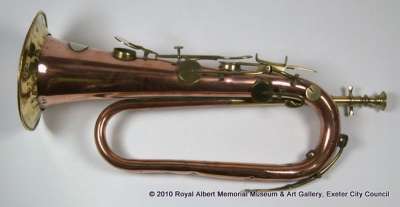Brass wind instrument
The traditional bugle is a simple wind instrument, without any valves and all pitch is controlled by the mouth. In 1811 Joseph Halliday, Bandmaster of the Cavan Militia, placed five side holes covered with keys on the bugle. This was the first attempt to obtain a chromatic scale on the bugle and it allowed a greater range of sound. The Keyed or Royal Kent Bugle – so called in honour of the Duke of Kent who patronised the instrument – was welcomed into military music, village bands, and theatre orchestra for the first half of the nineteenth century.
Shaped like a natural trumpet, the instrument is copper-plated with a brass strip around the bell. It has eight brass keys and a brass mouth-piece. The key above the bell has a double lever action, remaining open except when operated. The height of the key above the hole when at rest can be altered by a brass screw set into the longer key-lever. The keys are likely to have a full chromatic compass from middle C. The other seven keys are simple leaf-spring leavers with leather pads.
This Kent Bugle was donated to RAMM by Sir E Chaning Wills of Chudleigh, Devon.
Shaped like a natural trumpet, the instrument is copper-plated with a brass strip around the bell. It has eight brass keys and a brass mouth-piece. The key above the bell has a double lever action, remaining open except when operated. The height of the key above the hole when at rest can be altered by a brass screw set into the longer key-lever. The keys are likely to have a full chromatic compass from middle C. The other seven keys are simple leaf-spring leavers with leather pads.
This Kent Bugle was donated to RAMM by Sir E Chaning Wills of Chudleigh, Devon.
Object Summary
- Accession Loan No.
- 50/1917
- Collection Class
- Musical instruments
- Material
- ? brass (copper plated)brassleather
- Common Name
- brass wind instrument
- Simple Name
- musical instrument
- Period Classification
- George III (1760-1811); Regency (1811-1820)
- Production Town
- unk
- Production Country
- United Kingdom: England
- Production Person Surname
- unk
- Production Year Low
- 1811
- Production Year High
- 1830


